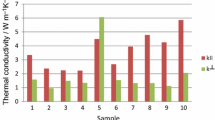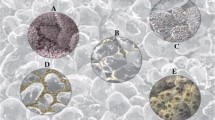Abstract
Although temperature is a main external effect on rock decay, the relationship between a rock’s decay rate and temperature still remains unclear and there is limited information about the rate of rock decay under varied temperatures during dry–wet cycle conditions in southwest China. Therefore, the aim of the present paper was to explore the rate of mudstone decay through an experiment, in which a model was proposed to calculate their decay rates under varied temperatures conditions. A set of customized test device, including a model test container, a thermostat-controlled heating plate, and a water supply and drainage device, was applied in the experiment. Three dry–wet cycles were conducted on five samples at 60, 90, 105, 120 and 180 °C, respectively. The crack width, vertical displacement and wetted area were measured to analyse the temperature-induced decay mechanism during dry–wet cycle processes. The results showed that tiny cracks appeared on the surface of samples after heating and that the vertical displacement increased in the upward direction due to swelling of the mudstone after water exposure. The crack width extended with increasing water exposure, but it decreased after the surface of samples was gradually wetted after several hours of water exposure. The continually increasing wetted area and progressively fast wetting speed were the outward manifestation of the increasing number of internal cracks. Temperature-induced stress could promote the generation of cracks and decay rates of the tested rocks raised with higher temperatures. Quantitative analysis revealed that the rock decay rate is significantly related to temperature in the form of a S-Curve. The sample barely decayed at 60 °C, but the decay rate was close to 90% at 180 °C. The higher the temperature was, the faster the wetting speed was and the more cracks generated, and ultimately rocks decayed as a result of crack extension.









Similar content being viewed by others
References
Anwar HZ, Shimada H, Ichinose M, Matsui D (1999) Slake durability behaviour of coal mine shales. In: Proceedings of 1999 international symposium on mining science and technology. Bejing, China, pp 343–346
Banwart SA, Berg A, Beerling DJ (2009) Process-based modeling of silicate mineral weathering responses to increasing atmospheric CO2 and climate change. Global Biogeochem Cycles 23(4):1277–1278. doi:10.1029/2008GB003243
Cantón Y, Solé-Benet A, Queralt I, Pini R (2001) Weathering of a gypsum-calcareous mudstone under semi-arid environment at Tabernas, SE Spain: laboratory and field-based experimental approaches. CATENA 44:111–132. doi:10.1016/S0341-8162(00)00153-3
Chen YL, Ni J, Shao W, Azzam R (2012) Experimental study on the influence of temperature on the mechanical properties of granite under uni-axial compression and fatigue loading. Int J Rock Mech Min Sci 56(15):62–66. doi:10.1016/j.ijrmms.2012.07.026
Eeckhout EMV (1976) The mechanisms of strength reduction due to moisture in coal mine shales. Int J Rock Mech Min Sci 13(2):61–67. doi:10.1016/0148-9062(76)90705-1
Eppes MC, Griffing D (2010) Granular disintegration of marble in nature: a thermal–mechanical origin for a grus and corestone landscape. Geomorphology 117(1–2):170–180. doi:10.1016/j.geomorph.2009.11.028
Erguler ZA, Shakoor A (2009) Relative contribution of various climatic processes in disintegration of clay-bearing rocks. Eng Geol 108(1–2):36–42. doi:10.1016/j.enggeo.2009.06.002
Erguler ZA, Ulusay R (2009) Water-induced variations in mechanical properties of clay-bearing rocks. Int J Rock Mech Min Sci 46(2):355–370. doi:10.1016/j.ijrmms.2008.07.002
Gautam TP, Shakoor A (2013) Slaking behavior of clay-bearing rocks during a one-year exposure to natural climatic conditions. Eng Geol 166:17–25. doi:10.1016/j.enggeo.2013.08.003
Guo YC, Xie Q, Wen JQ (2012) Effect of the alternation of heat and water on the slaking phenomenon of redbeds. Hydrogeol Eng Geol 39(5):69–73 (in Chinese)
Hale PA (2003) A laboratory investigation of the effects of cyclic heating and cooling, wetting and drying, and freezing and thawing on the compressive strength of selected sandstones. Environ Eng Geosci 9(2):117–130. doi:10.2113/9.2.117
Hall K (1997) Rock temperatures and implications for cold region weathering. i: new data from Viking valley, Alexander island, Antarctica. Permafr Periglac Process 8(1):69–90. doi:10.1002/(SICI)1099-1530(199701)8:1<69:AID-PPP236>3.0.CO;2-Q
Hall K (2004) Evidence for freeze–thaw events and their implications for rock weathering in northern Canada. Earth Surf Process Landf 29(1):43–57. doi:10.1002/esp.1012
Hall K, André MF (2001) New insights into rock weathering from high-frequency rock temperature data: an Antarctic study of weathering by thermal stress. Geomorphology 41(1):23–35. doi:10.1016/S0169-555X(01)00101-5
Heuze FE (1983) High temperature mechanical, physical and thermal properties of granitic rock-a review. Int J Rock Mech Min Sci Geomech Abstr 20(1):3–10. doi:10.1016/0148-9062(83)91609-1
Holland CT (1956) Mineral content, a factor in weathering of mine roof. Am Min Congr J 42(1):49–53
Krumbein WC, Sloss LL (1963) Stratigraphy and sedimentation, 2nd edn. W.H. Freeman and Co, San Francisco, p 269
Lau JSO, Gorski B, Jackson R (1995) The effects of temperature and water saturation on mechanical properties of Lac Du Bonnet pink granite. In: Eighth international congress on rock mechanics. Tokyo, Japan, pp 25–29
Liang B, Gao HM, Lan YW (2005) Theoretical analysis and experimental study on relation between rock permeability and temperature. Chin J Rock Mech Eng 24(12):2009–2012 (in Chinese)
Liu JR, Qin JS, Wu XD (2001) Experiment research on rock permeability effected by temperature. J Univ Petrol China 25(4):51–53 (in Chinese)
Lu Y, Wang L, Sun X, Wang J (2016) Experimental study of the influence of water and temperature on the mechanical behavior of mudstone and sandstone. Bull Eng Geol Environ. doi:10.1007/s10064-016-0851-0
McKay CP, Molaro JL, Marinova MM (2009) High-frequency rock temperature data from hyper-arid desert environments in the Atacama and the Antarctic dry valleys and implications for rock weathering. Geomorphology 110(3–4):182–187. doi:10.1016/j.geomorph.2009.04.005
Molinda GM, Oyler DC, Gurgenli H (2006) Identifying moisture sensitive roof rocks in coal mines. In: 25th International conference on ground control in mining. West Virginia, USA, pp 57–64
Pardini G, Guidi GV, Pini R, Regues D, Gallart F (1996) Structure and porosity of smectitic mudrocks as affected by experimental wetting-drying cycles and freezing-thawing cycles. CATENA 27(3):149–165. doi:10.1016/0341-8162(96)00024-0
Peel RF (1974) Insolation weathering: some measurements of diurnal temperature changes in exposed rocks in the Tibesti region, central Sahara. Zeitschrift für Geomorphologie 21:19–28
Phienwej N (1987) Ground response and support performance in a sheared shale, Stillwater Tunnel. Dissertation, University of Illinois, pp 59–62
Regüés D, Pardini G, Gallart F (1995) Regolith behaviour and physical weathering of clayey mudrock as dependent on seasonal weather conditions in a badland area at Vallcebre, Eastern Pyrenees. CATENA 25(1):199–212. doi:10.1016/0341-8162(95)00010-P
Reinds GJ, Posch M, Leemans R (2009) Modelling recovery from soil acidification in european forests under climate change. Sci Total Environ 407(21):5663–5673. doi:10.1016/j.scitotenv.2009.07.013
Sadisun IA, Shimada H, Ichinose M, Matsui K (2005) Study on the physical disintegration characteristics of subang claystone subjected to a modified slaking index test. Geotechn Geol Eng 3(3):199–218. doi:10.1007/s10706-003-6112-6
Silva MRD, Schroeder C, Verbrugge JC (2008) Unsaturated rock mechanics applied to a low-porosity shale. Eng Geol 97(1):42–52. doi:10.1016/j.enggeo.2007.12.003
Smith BJ, Warke P (1996) Processes of Urban Stone Decay. Donhead, London, pp 3–18
Sumner PD, Hedding DW, Meiklejohn KI (2007) Rock surface temperatures in southern Namibia and implications for thermally-driven physical weathering. Zeitschrift Für Geomorphologie Supplementary Issues 51(1):1572–1579. doi:10.1127/0372-8854/2007/0051S-0133
Sumner PD, Hall KJ, van Rooy JL, Meiklejohn KI (2009) rock weathering on the eastern mountains of southern Africa: review and insights from case studies. J Afr Earth Sci 55(5):236–244. doi:10.1016/j.jafrearsci.2009.04.010
Unrug K (1997) Weatherability test of rocks for underground mines. In: 16th International conference on ground control in mining. Morgantown, WV, USA, pp 259–266
Warke PA, Smith BJ (1998) Effects of direct and indirect heating on the validity of rock weathering simulation studies and durability tests. Geomorphology 22(3):347–357. doi:10.1016/S0169-555X(97)00078-0
Weiss T, Siegesmund S, Kirchner D, Sippel J (2004) Insolation weathering and hygric dilatation: two competitive factors in stone degradation. Environ Geol 46(3):402–413. doi:10.1007/s00254-004-1041-0
Whalley WB, Turkington AV (2001) Weathering and Geomorphology. Geomorphology 41(1):1–3. doi:10.1016/S0169-555X(01)00142-8
Yang GS, Pu YB, Ma W (2002) Discussion on the damage propagation for rock under the frost and thaw condition of frigid zone. J Exper Mech 17(2):220–226 (in Chinese)
Yang ZC, Zhang JY, Zhou DP (2006) Study on fast weathering characteristics of red bed mudstone slope. Chin J Rock Mech Eng 25(2):275–283 (in Chinese)
Yang JL, Wang LG, Li XL, Zhao G (2014) Research on micro-fracture mechanism of mudstone after wet-dry cycles. Chin J Rock Mechan Eng 33(A02):3606–3612. doi:10.13722/j.cnki.jrme.2014.s2.027 (in Chinese)
Zhang SX (2008) Research on relationship between substantial composing and mechanical parameters of mudstone in Chongqing. Chongqing Jiaotong University, Chongqing, China, p 9 (in Chinese)
Zhang D, Chen AQ, Xiong DH, Liu GC (2013) Effect of moisture and temperature conditions on the decay rate of a purple mudstone in southwestern China. Geomorphology 182:125–132. doi:10.1016/j.geomorph.2012.11.003
Zhang L, Mao X, Liu R, Guo X, Ma D (2014) The mechanical properties of mudstone at high temperatures: an experimental study. Rock Mech Rock Eng 47(4):1479–1484. doi:10.1007/s00603-013-0435-2
Zhang D, Chen A, Wang X, Liu G (2015) Quantitative determination of the effect of temperature on mudstone decay during wet-dry cycles: a case study of ‘purple mudstone’ from south-western China. Geomorphology 246:1–6. doi:10.1016/j.geomorph.2015.06.011
Zhang W, Sun Q, Cao L, Wang B (2017) Thermal damage on claystone after exposure to different high temperatures: a review. Geotech Test J 40(2):351–360. doi:10.1520/GTJ20160106.ISSN0149-6115
Acknowledgements
The authors gratefully acknowledge the financial support from the Chongqing Research Program of Basic Research and Frontier Technology (No. cstc2015jcyjBX0073) and the science and technology project of Land Resources and Real Estate Management Bureau of Chongqing Government (No. CQGT-KJ-2014052).
Author information
Authors and Affiliations
Corresponding author
Rights and permissions
About this article
Cite this article
Hu, M., Liu, Y., Ren, J. et al. Temperature-Induced Deterioration Mechanisms in Mudstone during Dry–Wet Cycles. Geotech Geol Eng 35, 2965–2976 (2017). https://doi.org/10.1007/s10706-017-0295-8
Received:
Accepted:
Published:
Issue Date:
DOI: https://doi.org/10.1007/s10706-017-0295-8




